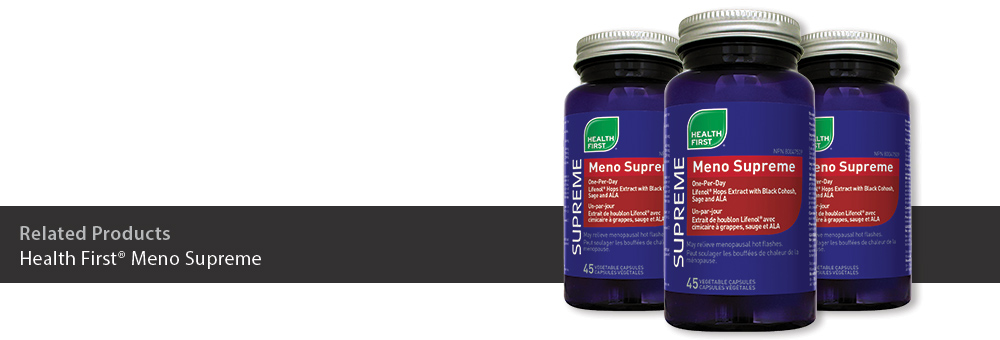

Menopause – A new phase of life
Menopause is the phase of a woman’s life, typically between the ages of 40 and 55, when ovulation and fertility come to an end. The World Health Organization defines menopause as 12 consecutive months without menstruation and the absence of viable eggs in the ovaries. During this time, the ovaries begin to shut down and stop producing two hormones, estrogen and progesterone, that play a major role in a woman’s life.
Associated with menopause and the related hormonal changes are several uncomfortable symptoms. These can include hot flashes, sweating, insomnia, headaches, vaginitis, nervousness, forgetfulness and concentration issues – all of which can make menopause a challenging time of life. In addition, bone loss and the risk of cardiovascular disease become elevated. The period before menopause, perimenopause, is a time of fluctuating hormone levels and can see the onset of some menopausal symptoms.
The severity of these symptoms differs for each individual woman, but seem related to diet and environment. Women in many regions of the world have less severe symptoms than women from North America and Western Europe.
Another issue affecting the severity of menopausal symptoms is the functioning of the adrenal glands. A woman’s adrenal glands can continue to supply estrogen and progesterone to the body after the onset of menopause. However, stress, poor diet, insufficient sleep, and caffeine consumption can interfere with adrenal functioning, making menopause symptoms more intense.
Hot flashes – The number one menopausal challenge
The “hot flash” is the most prevalent of all menopausal symptoms. In North America and Western Europe, 72% of menopausal women experience hot flashes.1 These can vary for each woman in frequency – from just a few per month to several within an hour – and in life-span duration – between five to forty years.
Hot flashes are known as a “vasomotor” symptom. During a hot flash, a woman’s heart rate can increase by as much as 5 beats per minute and skin temperature can dramatically rise. The symptoms of hot flashes are felt primarily in the face, neck and upper body and are accompanied by increased sweating. The actual core temperature of the body decreases due to the loss of heat through sweating.
Experiencing hot flashes is certainly uncomfortable, but even worse; they can dramatically affect quality of life by interfering with daily routines. They can lead to sleep interruption, insomnia, increased anxiety and irritability.
Low estrogen levels are thought to be a factor the cause of hot flashes. Estrogen helps to regulate the body’s internal core temperature. In menopausal women, even slight changes in internal core temperature appear to trigger cooling actions (sweating and hot flashes) as there is insufficient estrogen to properly mediate these actions. The process is not entirely understood as there are certainly other factors involved – some women do not experience hot flashes while going through menopause and the associated decrease in estrogen.
HRT – Risks of hormone replacement therapy
The primary treatment for hot flashes used by the medical establishment has been hormone replacement therapy (HRT). HRT is the use of conjugated estrogen (Premarin®) or a combination of estrogen with progesterone to replace the absence of these hormones during menopause. In terms of results, HRT has been effective in reducing hot flashes, preventing bone loss and fractures and treating vaginal dryness.
Despite the benefits of HRT, three major clinical reviews of HRT outcomes were published between 2002 and 2010, which brought to light the risks of this therapy. Unexpectedly, HRT was shown to significantly increase the risk of heart attacks, strokes, blood clots, breast cancer, endometrial cancer (when estrogen given singularly) and gallbladder disease.3
Due to these elevated adverse outcomes, the majority of doctors in North America discontinued their patients’ HRT use. HRT is now generally only used for women with severe menopausal symptoms and even then only in the smallest dose, over the shortest time period.
Some health professionals prescribe the use of “bioidentical” hormones extracted from soy or wild yams, which are considered less potent and safer than HRT. These hormones are available at pharmacies in a variety of forms. Unfortunately, despite being theorized as safer than HRT, there have been no large clinical trials to confirm the safety of bioidentical hormones.4
Natural alternatives to HRT
With the move away from HRT, women have had to look at other alternatives to deal with menopausal symptoms. Reducing stress, exercising regularly, avoiding smoking and ensuring a positive healthy environment can all help.5 The use of natural supplements designed for relieving menopausal discomfort can also play a role for menopausal women seeking relief.
In recent times, natural soy-based foods and plant extracts like black cohosh and red clover have been used to by women to help ease menopausal symptoms such as hot flashes. These plants contain phytoestrogens or “dietary estrogens”, meaning they are estrogenic compounds consumed through food and not produced in the endocrine system. Phytoestrogens have estrogenic effects in the body, meaning they mimic estrogenic effects. Soy-based phytoestrogens include the isoflavones genistein and daidzein.
A phytoestrogen source has now been identified to have even greater effect than soy-based products. Hops (Humulus lupulus L.), the plant best known for its use in beer, has been found to be rich in a phytoestrogen called 8-prenylnaringenin (8-PN). 8-PN is a prenylflavonoid and a standardized 8-PN material has been developed from hops and studied in human clinical trials for the relief of hot flashes.
Lifenol® – Clinically-proven hops extract
The hops extract branded as Lifenol® contains 0.15-0.25% of 8-PN. This material has been studied in human clinical trials for safety and effectiveness against menopausal symptoms.
In one clinical trial, menopausal women were given either a placebo or supplement containing 85 mg of Lifenol®. After six weeks, 60% of the women using the supplement containing Lifenol® had experienced a reduction in hot flashes. Those women experienced an average 30% decrease in hot flashes.6
A second Lifenol® study evaluated overall quality of life for menopausal women. Again, menopausal women were given either a placebo or supplement containing 85 mg of Lifenol®. A promising 90% of women who were on the Lifenol® supplement reported improved quality of life and three times as many women in the Lifenol® group reported a “strong” improvement within 6 weeks. The symptoms that were measured included sweating, insomnia, nervousness and vertigo.7
Black cohosh and sage – Other herbs for menopausal relief
8-PN from hops is not the only phytonutrient with beneficial effects for menopausal symptoms. Black cohosh is a phytoestrogen that has been useful in reducing the incidence of hot flashes. In one study, 40 mg of black cohosh was as effective as conjugated estrogens, but did not affect the endometrial thickness of the uterus lining like the estrogen therapy. In another study, 80% of women reported reductions in menopausal issues within one month of use.17
Sage, an herb with a long history of numerous traditional uses, is also known to be useful for reducing hot flashes and sweating at night.18
References:
1. Nelson HD (2008) Menopause. Lancet 371(9614): 760–70. doi: 10.1016/s0140-6736(08)60346-3
2. “Natural solution for hot flashes”. Naturex.
3. Murray, Michael, N.D. “The Encyclopedia of Natural Medicine.” Third Edition. Atria. p. 784-785.
4. p. 786.
5. Torkos, Sherry, BSc Phm. “The Canadian Encyclopedia of Natural Medicine.” Second Edition. 2013. HaperCollins Publishers. pp 348-349.
6. Erkkola, R. et al., A randomized, double-blind, placebo-controlled, cross-over pilot study on the use of a standardized hop extract to alleviate menopausal discomforts. Phytomedicine (2010), doi:10.1016/j.phymed.2010.01.007
7. Heyerick, A. et al. A first prospective, randomized, double-blind, placebo-controlled study on the use of a standardized hop extract to alleviate menopausal discomforts. Maturitas 54 (2006) 164-175.
8. Rad, M., et al. Pharmokinetics and systemic endocrine effects of the phytoestrogen 8-prenylnaringenin after single oral doses to postmenopausal women. Br. J. Clin. Pharmacol. 62:288-296.
9. Bolca, Selin et al. Disposition of hop prenylfavonoids in human breast tissue. Mol. Nutr. Food Res. 2010. 54, 1-11.
10. “Effects of Lifenol® on the endometrium and vaginal cytology of menopausal women.” Unpublished.
11. “Renew your sense of womanhood with Lifenol.” 2012.
12. Brunelli, E. “8-prenylnaringenin inhitibs epidermal growth factor-induced MCF-7 breast cancer cell proliferation by targeting phosphatidylinositol-3-OH kinase activity. 2009. J Steroid Biochem. Mol. Biol. 113:163-170.
13. Pepper, MS. “8-prenylnaringenin, a novel phytoestrogen, inhibits angiogenesis in vitro and in vivo.” J Cell Physiol, 2004 Apr; 199 (1): 98-107.
14. Effenberger, K.E. et al. Regulation of osteoblastic phenotype and gene expression by hop-derived phytoestrogens. J. Steroid Biochem. Mol. Biol. 96:387-399.
15. Sehmisch, S. Comparison of the phytohormones genistein, resveratrol and 8-prenylnaringenin as agents for preventing osteoporosis. Planta Med. 2008. 74:794-801.
16. Fromentin, Emillie. “Lifenol® is not a traditional hops extract for insomnia.” Internal paper.
17. Murray, Michael, N.D. “The Encyclopedia of Natural Medicine.” Third Edition. Atria. p. 790.
18. Health Canada. “Monograph: Sage”. Natural Health Products Directorate. http://webprod.hc-sc.gc.ca/nhpid-bdipsn/atReq.do?atid=sagor&lang=eng

